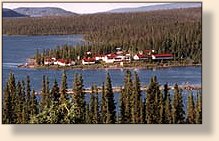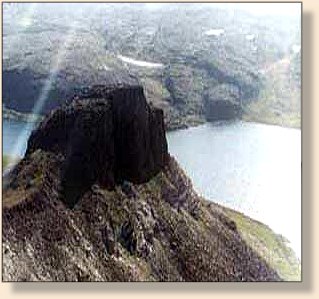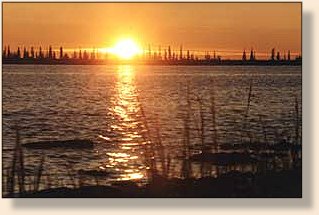Great Slave Lake, Part 2
By Chris Hanks
A few days later, as I chatted with Ragnar Westrom, he casually
let it drop that he had guided Michigan angler, Herb Nofferts, into
enough Artic grayling and northern pike that he had sworn off Alaska.
They struck pay dirt a couple of miles from where we were skunked.
One evening later in the week, I walked in from the Dettah Road to
the far shore of Yellowknife Bay looking for northern pike. I
resoundingly connected with a Red and White Bunny Fur Streamer off a
weed bed. It is a simple pattern. A long white rabbit tail, a red body
wrapped with heavy copper wire - to retard chewing - and a couple of
turns of saddle hackle mated to a long, size 2 streamer hook. They
take two minutes to tie and will, with luck, last through a few savage
raps by a pike.
Angling pressure around Yellowknife has increased since Gerry Wolfe
and I used to go down to Wool Bay after pike in the early 90s. As the
water quality has improved, there seem to be more lake trout in Yellowknife
Bay than there have been for many years. Despite concern for the
Yellowknife River Arctic grayling run, fishing for grayling around the
north shore islands is still good. Quantities of healthy northern
pike lurk near town. If the move toward catch and release continues to
grow with Yellowknife sportsmen, the sports fishery should remain strong.
Yellowknife is a hub for air and water traffic to the East Arm of Great
Slave Lake. The inside passage through the islands is accessible to
boaters who know the water, but shoals make the trip through the
archipelago to the East Arm treacherous for the uninitiated. Larger
crafts follow the shipping channel across the main body of the lake.
Travel on the outside, however, is exposed and subject to changes in
the weather. It is not uncommon to find boats from Yellowknife at Fort
Reliance on the far end of the East Arm.

The East Arm is big water. Vertical cliffs on Red Cliff Island soar
hundreds of feet above the arm, while the lake plunges into subterranean
canyons several thousand feet deep. (It is deeper than Great Bear Lake and
Lake Superior.) The fishing is spectacular but it takes more than a
summer vacation to learn the water.

Your best bet is to go through a lodge. Trophy Lodge at Fort
Reliance is a short boat trip from the mouths of the Lockhart
and Hoar Frost rivers. Frontier Lodge, by the
mouth of Snowdrift River, has exceptional Arctic grayling, northern pike
and lake trout fishing. Both are accessible by air from Yellowknife.
The Katseyedie River near Plummer's Lodge produced the all tackle record
for Arcic grayling. The trophy was 29 7/8 inches long and weighed five
pounds, 15 ounces. Guest regularly take trophy northern pike and lake
trout in addition to the Arctic grayling. Plummer's Lodge has direct
weekly air service from Winnipeg, Manitoba.
East Arm sports fishing is largely based on trolling for lake trout
with hardware. Despite this, all of the lodges have excellent opportunities
to take Arctic grayling, northern pike and whitefish on the fly. Early
in the season lake trout can be apprehended near the surface with
streamers and occasionally on dry flies.
 Travelling in the north, the size of one's creel is limited by the
space available on small planes. My 8 weight rod would stand the
task of bringing a hefty lake trout up through the current, but could
I get down and drift a deceptive tidbit past those scour pocket dwellers?
As a compromise to space, I had only brought floating and medium density
sinking lines with me. All my weighted nymphs and streamers were lightly
leaded, none were real sinkers. My frustration grew as my partner George
Pellessey took trout after grayling with a heavy spoon, while I watched
the current drift my flies well above the fish. With a mitt full of split
shot clamped to my leader, a pair of nymphs would almost lay out and drift
along the bottom. Whenever I thought I had a good run started, however,
the fly line would become hydrodynamic at the wrong moment and soar the
flies off the bottom.
Travelling in the north, the size of one's creel is limited by the
space available on small planes. My 8 weight rod would stand the
task of bringing a hefty lake trout up through the current, but could
I get down and drift a deceptive tidbit past those scour pocket dwellers?
As a compromise to space, I had only brought floating and medium density
sinking lines with me. All my weighted nymphs and streamers were lightly
leaded, none were real sinkers. My frustration grew as my partner George
Pellessey took trout after grayling with a heavy spoon, while I watched
the current drift my flies well above the fish. With a mitt full of split
shot clamped to my leader, a pair of nymphs would almost lay out and drift
along the bottom. Whenever I thought I had a good run started, however,
the fly line would become hydrodynamic at the wrong moment and soar the
flies off the bottom.
George finally suggested that I attach a trolling sinker to the end of
my fly line. In honor of his invention, he took the first cast.
Actually cast is a misnomer, I pitched the lead and leader out into
the current and the fly line followed. George drew a strike on a
size 2 Mickey Finn during the first drift. The weight at the end of
the line was so heavy, however, that he could not keep pressure on the
fish as the leader quaked like a string tied to a post in a windstorm.
With the point proven, he grabbed a hacksaw from the boat box and cut
the weight in half. The revised contraption actually hooked lake
trout with fair regularity. Arctic grayling seemed to hit too softly
for me to feel the take with all the pressure on the tackle.

When I got back to Yellowsknife, I ripped open Dan Bailey's catalogue
and ordered another spool, a high density full sinking line and a
handful of lead heads. At the bench I created an assortment of very
heavy nymphs, including some brassies that require a hard-hat when
you cast them. Later, I had another shot at the mouth of the Lockhart.
I found, much to my satisfaction, that I could tumble a fly along the
bottom, fight a fish and actually call it fly fishing. When that
infrequently used line wears out, I think I will replace it with a
running line and shooting heads. The combination will give me
more flexibility. The thin running line will belly less in heavy current
and I can carry specialty items like a lead core head without wasting
an entire spool. ~ Chris Hanks
From Fly Fishing in the Northwest Territories of Canada, Published
by Frank Amato Publications.We appreciate use permission. Photos courtesy Yellowknife Tourism.
Our Man In Canada Archives
|

